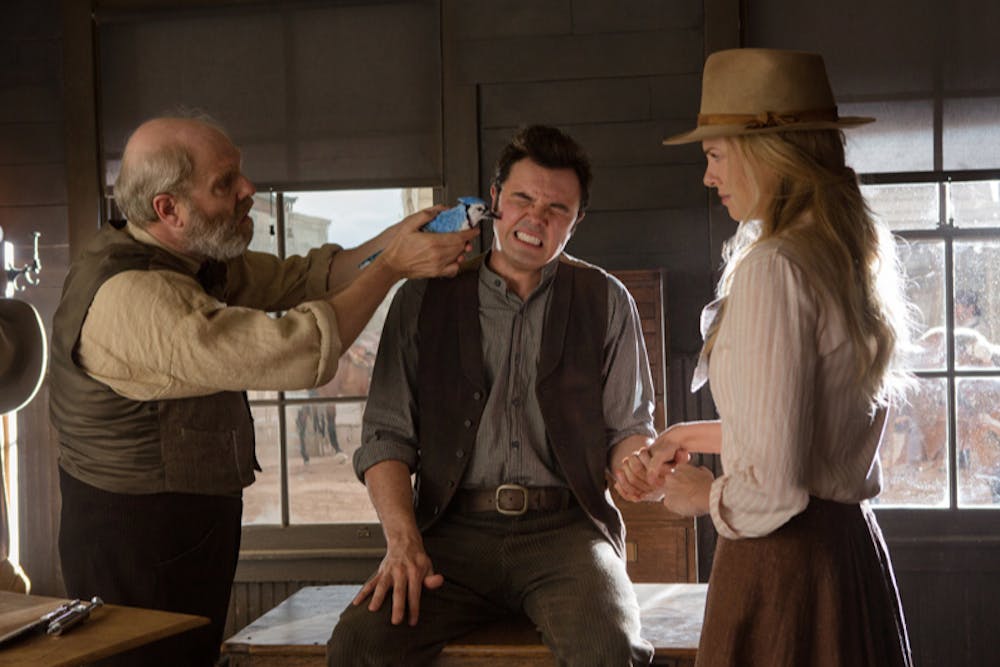Western films haven’t captured the attention of American audiences for years, not since John Wayne and Clint Eastwood were trailblazers in Hollywood. The only thing close may have been the 2007 remake of “3:10 to Yuma,” “There Will Be Blood” or 2010’s “True Grit.” But a comedic Western movie? That doesn’t work either, not even for Seth MacFarlane and his latest creation, “A Million Ways to Die in the West.”
Every comedian has a brand, and MacFarlane’s has worked for him for decades. The success of the TV series “Family Guy,” which first aired in 1999, brought his breed of comedy to the masses — off-color humor that makes the viewer think mixed with potty jokes that make most everyone break out into giggles. MacFarlane’s brand has continued to thrive in other media — TV spin-offs like “The Cleveland Show” and the 2012 megahit movie “Ted” — yet his latest project does not engage audiences in quite the same way. Frankly, nothing about MacFarlane’s new film “A Million Ways to Die in the West” is unexpected.
One of the biggest draws to “A Million Ways to Die…” is its A-list cast. MacFarlane plays the protagonist of the film, Albert Stark. Stark is a sheep farmer who despises his life in the frontier town of Old Stump, Arizona. Within the first 10 minutes of the film, he is dumped by his girlfriend Louise, played by Amanda Seyfried ( “Les Miserables”) and for the remainder of the film, Stark is trying to win back her love.
Along the way, Stark meets Anna (Charlize Theron, “Prometheus”), the “new girl” in town who also happens to be the wife of the most notorious bandit in the West, Clinch Leatherwood (Liam Neeson, “The Grey”). Stark begins to fall in love with Anna — without knowing her true identity, of course — while training to duel Louise’s new boyfriend Foy, inexplicably played by Neil Patrick Harris (“How I Met Your Mother”).
Twists and turns occur, especially when Leatherwood arrives in Old Stump looking for Anna, yet nothing about the ending is out of the ordinary. Not one member of the cast seems to have any passion or conviction when fulfilling their role, besides maybe MacFarlane. That is likely only because he directed, produced, wrote and acted in the film. The lack of chemistry is most obvious between Theron and MacFarlane. Their love story is dispassionate and unbelievable, and although this film is intended to be a comedy, the plot cannot be centered around two characters who have a mediocre compassion for each other.
The humor is silly, with one-liners spewed left and right and bathroom jokes always an integral part of the film. And just like in “Family Guy,” there are the occasional intelligent jokes that make you laugh harder if you understand them. Some of the best parts of the movie involved supporting characters, like comedienne Sarah Silverman’s character Ruth, a prostitute who won’t have sex with her long-term boyfriend because that would mean they would have pre-marital relations. Gilbert Gottfried finds his way into the film as well as Abraham Lincoln, which is worth seeing to believe.
The type of humor MacFarlane created with “Family Guy” works in short timeframes, like the half-hour long episodes. Yet the potty humor and the often racist, misogynist and otherwise insensitive material that work as one-liners on TV don’t work on screen for nearly two hours. The movie drags, and the audience doesn’t gain anything in those extra minutes. While there are several bright spots, “A Million Ways to Die in the West” probably isn’t worth seeing in theaters unless you’re partial to a good potty joke.
“A Million Ways to Die in the West” (R, 116 minutes) is now playing at AMC Mazza Gallerie, Regal Gallery Place and AMC Georgetown.





